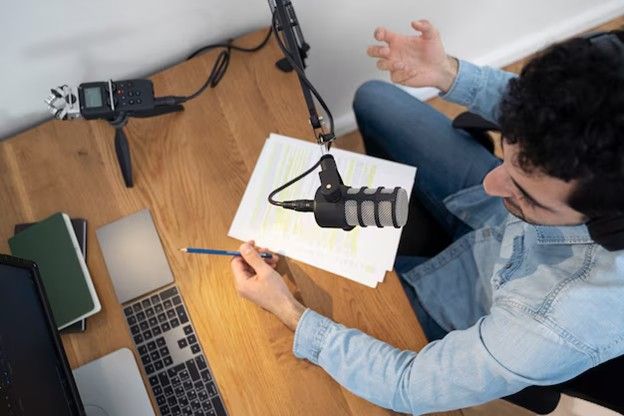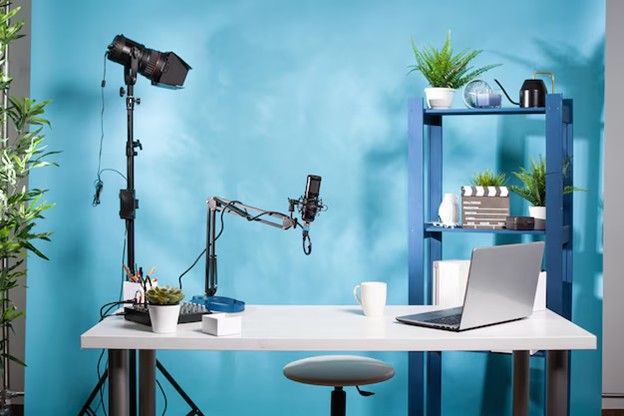Podcasting on YouTube on YouTube is most certainly one of the fastest ways to reach more people. Apart from video content, YouTube offers podcasters a vivid platform with around 2.5 billion active users. The problem is more on how to start a podcast on YouTube than on whether you should start one.
Unlike traditional audio-only systems, YouTube allows podcasters to clearly communicate with their audience, hence enhancing participation. Whether your goal is to launch a brand-new podcast or expand an existing one, YouTube offers unparalleled discoverability and revenue options. Moreover, video podcasts allow podcasters to emphasize expressions, emotions, and other nonverbal cues not possible in traditional audio versions, therefore strengthening the relationship with viewers.
Another good reason to select YouTube is its built-in search engine. Google controls YouTube, hence its videos show up highly in search results, which helps new listeners of your work to find it. Using technologies like YouTube Shorts, live streaming, and community postings podcasters might also highlight their topic in multiple ways to keep viewers interested.
How to Start a Podcast on YouTube from Scratch?
How to make a podcast on youtube: It requires more than gathering and uploading materials. It's about organizing, creating, and refining your material to keep viewers interested. This is a detailed walk-through guide on starting a YouTube podcast.
Step 1: Plan Your YouTube Podcast

You need a strong plan before you push the record. In a market become more and more congested, a well-considered podcast has more chance to stand out. Planning calls for determining your niche, choosing a structure, organizing your episodes, and creating a content calendar.
Choosing a Podcast Niche & Topic – How to Stand Out?
Choosing a niche is about discovering the correct angle that distinguishes your podcast, not only about selecting a topic. Examine popular YouTube podcasts in your field of interest and note what works. Then, figure out how you might add your own voice and viewpoint. Whether your concentration is on tech, real crime, or personal growth, make sure your material is clearly oriented. Additionally, take into account the kind of material people are actively looking for and how you might add value in a unique and competitive manner.
Picking the Right Format – Solo, Interviews, or Roundtable?
Your approach to communicating with your listeners shapes your podcast. Deep dives into subjects are best suited for a solo podcast; guest appearances from interviews help attract fresh listeners. Dynamic and interesting conversations benefit much from roundtable discussions. Whatever you decide, consistency is really important. Booking well-known visitors will help you greatly increase your reach should you choose to go the interview path since they would most likely share the episode with their fans.
Structuring Your Episodes for Maximum Engagement – Hooks, Segments, and Calls to Action
A well-organized episode captivates viewers. Start with a strong hook that catches viewers in the first thirty seconds. Divide the program into discrete sections and always finish with a call to action—ask viewers to share, subscribe, or comment. Timestamps will assist listeners in negotiating themes in your podcast; employ interesting narrative devices to keep listeners till the very last.
Step 2: Set Up Your YouTube Podcast Studio

A great podcast is about quality as much as its content. Great audio and video promote audience retention and enhance your credibility. Depending on how you arrange your podcast, its look will be considerably more professional.
Best Microphones for YouTube Podcasts
A good microphone is essential for clear and professional sound. The USB & XLR Condenser Microphone is a great option for podcasters looking for crisp audio. Still more solid possibilities include the Shure SM7B and the Rode NT1. Using a pop filter and adjusting the microphone's location will help to improve audio quality and lower background noise.
Best Cameras for Video Podcasts
The professional appeal of your podcast might be ruined or enhanced by your camera quality. The 4K Streaming Camera is perfect for those wanting high-definition visuals. Two further great options are the Sony ZV-1 and Logitech StreamCam. Make sure your camera mounts firmly and has suitable lighting if you want a clear image all through your video.
Lighting & Background Setup – How to Create a Professional Look
Good illumination moves shadows out of the way and enhances video quality. For LED ring lights or evenly illuminated softbox lighting. Maintaining professionalism calls for a background free of clutter and aesthetically pleasing. Consider using a booksheveled arrangement or a backdrop to complement your brand.
Step 3: Record & Edit Your YouTube Podcast

Your setup ready now is time to record and edit your podcast. Correct instruments and software will help to guarantee a flawless result at last. Constant recording quality and a good post-production technique define success. Good preparation helps to improve the final outcome and ease editing, thereby reducing time spent on revisions. Before starting, always complete a sound and visual check to guarantee perfect setup.
Best Podcast Recording Software
Among the most used programs are Obs Studio, best for local recording and live streaming.
- OBS Studio – Best for live streaming and local recording.
- Riverside.fm – Great for remote interviews and high-quality audio/video.
- Adobe Audition – A top-tier audio editing tool for professionals.
Each one of these program options presents particular benefits. OBS Studio is quite good for those seeking a free, open-source program fit for live streaming. Designed particularly for podcasters and remote interviews, Riverside.fm offers excellent sync-ability from premium recordings. High-end projects would seek for Adobe Audition, an industry-standard tool with strong noise reduction, multitrack editing, and audio restoration features.
How to Record High-Quality Audio & Video?
Using a Portable Audio Mixer like the NearStream AMIX40U allows for precise control of audio levels. Sound quality can be much improved in your environment by properly mic positioning and soundproofing. Pop filters also help to reduce unwanted noise and mounting shock. Perfect microphone placement guarantees sharp, clear audio free of distortion—between six and twelve inches from your mouth.
For video, ensure your camera is set up at eye level for a natural look. Using a high-quality 4K Streaming Camera will enhance visual clarity, making your podcast appear more professional. By use of appropriate lighting placement, soft lights from many angles serve to minimize shadows and provide a polished final image.
Editing Like a Pro
Programs include Final Cut Pro, DaVinci Resolve, and Adobe Premiere Pro enable clean edits, creative visuals, and perfect transitions. Dynamic visuals and captions help to raise attention and accessibility. Multicam editing techniques help to enhance podcasts including guest interviews so facilitating more fluid speaker changes.
Still, another vitally necessary technique is audio mastering. Among other tools, iZotope RX can aid with vocal clarity, sound level adjustment, and background noise elimination. Compression and equalizing guarantees that your audio stays clear and professional, therefore enabling the listener to follow along. Last but not least consider integrating background music or intro/outro sound effects to create a polished and immersive listening experience.
Step 4: Upload & Optimize Your Podcast on YouTube

Uploading is more about optimizing a video for viewing than mere distribution. The right title, description, and thumbnail will greatly improve the performance of your video, thereby allowing it to rank higher in search results and generate more views. Using YouTube's algorithm, a well-optimized video has more possibilities to be suggested, therefore improving your interaction and reach.
Creating a Podcast Playlist on YouTube – Step-by-Step Guide
A dedicated playlist allows YouTube to recommend your audio to users. Create one playlist for all of your episodes so viewers may binge-listen without having to search for every one of them. This boosts view time, which is a major factor influencing YouTube ranks. Moreover enhancing user experience is logical sequential structuring of episodes—that is, by theme, season, or guest category.
Titles, Descriptions & Tags for Searchability – YouTube SEO Strategies
Search-friendly titles include keywords like how to create a podcast on YouTube helps search ranking improve. Descriptions should call for timestamps, relevant links, and a quick overview of every episode. Adding detailed tags incorporating variants of your core keyword and associated terms like "podcast tips" or "video podcast setup," your video becomes more discoverable. Regularly employing custom thumbnails with bold text and interesting photos would help YouTube's algorithm—click-through rates—to be strengthened.
Step 5: Promote & Monetize Your YouTube Podcast
Your podcast should be live right now hence, you should focus on development and income generation. Without encouragement, even the best content can struggle to get acknowledged. To raise awareness of your podcast, you should aggressively advertise it on several outlets.
How to Grow Your Podcast Audience – Social Media, Collaborations & SEO
If you want to increase your listeners, you must promote your podcast through email newsletters, social media, and collaborations. Share behind-the-scenes documents, highlight reels, and short video clips to generate awareness. Including your audience in live Q&As, community postings, and comments develops a loyal following. Guest collaborations are another great strategy for expansion; more people will come to your resources when guests forward your podcast to their listeners.
Monetization Strategies – YouTube Ads, Sponsorships, Super Chats, Memberships
Once you have traction, choices for monetization consist in:
- YouTube Advertisements: Make money from the ones shown in your videos.
- Sponsorships: Join forces with companies to advertise goods fit for your market.
- Super Chats & Channel Memberships: Allow viewers to support you directly through donations or exclusive membership perks.
- Afford Marketing: advertise goods or services and get paid commissions from sales brought about by your referral links.
Beyond YouTube, podcasters can reach an even bigger audience and diversify income sources by distributing their material on Spotify and Apple Podcasts. Using several monetizing strategies guarantees steady podcast increase and helps generate a consistent income over time.
Final Thoughts – Launching Your Podcast on YouTube
Creating a brand, interacting with an audience, and using the strong algorithm of the site to reach more people define YouTube podcasting more than merely publishing videos. You grow sooner the earlier you start.






































































